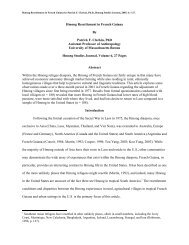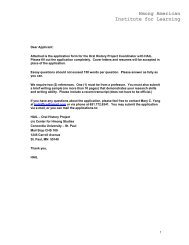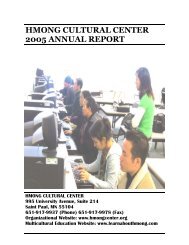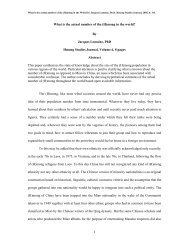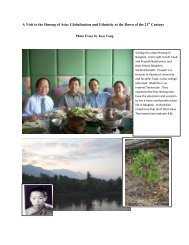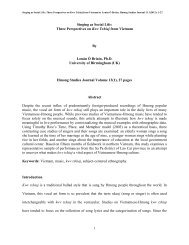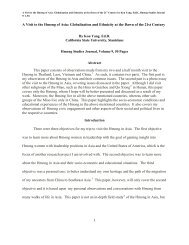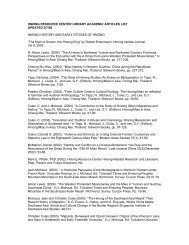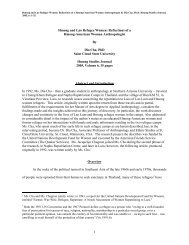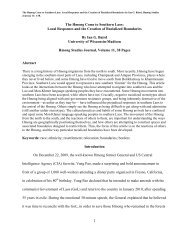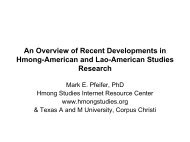Research Notes from the Field - Hmong Studies Internet Resource ...
Research Notes from the Field - Hmong Studies Internet Resource ...
Research Notes from the Field - Hmong Studies Internet Resource ...
You also want an ePaper? Increase the reach of your titles
YUMPU automatically turns print PDFs into web optimized ePapers that Google loves.
<strong>Research</strong> <strong>Notes</strong> <strong>from</strong> <strong>the</strong> <strong>Field</strong>:Tracing <strong>the</strong> Path of <strong>the</strong> Ancestors – A Visit to <strong>the</strong> <strong>Hmong</strong> in China by Kou Yang, EdD,<br />
<strong>Hmong</strong> <strong>Studies</strong> Journal, 2005, 6: 1-38.<br />
population in China. The province is home to about twenty-five ethnic groups who represent approximately<br />
thirty percent of <strong>the</strong> total Yunnan population. These Yunnan ethnic minorities include Achang, Bai, Bouyei,<br />
Blang, Dai, Deang, Drung, Hani, Miao, Hui, Jingpo, Jino, Lahu, Lisu, Manchu, Mien/Yao, Mongolian, Naxi,<br />
Nu, Pumi, Va, Shui, Tibetan, Yi, and Zhuang. Ancestors of <strong>the</strong> <strong>Hmong</strong> in Sou<strong>the</strong>ast Asia come mostly <strong>from</strong><br />
<strong>the</strong> Yunnan province, so <strong>the</strong> <strong>Hmong</strong> in Sou<strong>the</strong>ast Asia share many similarities with some of <strong>the</strong> numerous<br />
sub-groups of <strong>the</strong> Miao in Yunnan, especially language, costumes, and certain traditions. About nine hundred<br />
thousand of <strong>the</strong> estimated ten million Miao in China live in Yunnan. There is no Miao autonomous prefecture<br />
in Yunnan. Both <strong>the</strong> Zhuang and Miao share <strong>the</strong> Wenshan Zhuang and Miao Autonomous Prefecture. There<br />
are three autonomous counties in Yunnan that are officially designated as Miao autonomous counties. These<br />
three counties are Pingpian, Jinping, and Lugan.<br />
A very large population of <strong>the</strong> Miao in Yunnan is concentrated near <strong>the</strong> border of Vietnam, Laos, and<br />
Myanmar. Before <strong>the</strong> Secret War in Laos or before 1960, many <strong>Hmong</strong> in Laos and China traveled back and<br />
forth between <strong>the</strong> two countries. Many <strong>Hmong</strong> immigrated to Laos <strong>from</strong> China as recently as <strong>the</strong> middle of<br />
<strong>the</strong> twentieth century. During his visit to China in 1987 and 1988, this author met several <strong>Hmong</strong> in<br />
Guangxi, whose language was <strong>the</strong> same as those of <strong>the</strong> <strong>Hmong</strong> of Sou<strong>the</strong>ast Asia, and <strong>the</strong>y related that <strong>the</strong>y<br />
have distant relatives in Sou<strong>the</strong>ast Asia, France, and <strong>the</strong> United States. In 1993, an elderly <strong>Hmong</strong> Chinese<br />
person, who lived near <strong>the</strong> border of Laos and Vietnam, informed this author that some of his relatives moved<br />
back <strong>from</strong> Laos to China before <strong>the</strong> establishment of <strong>the</strong> People’s Republic of China in 1949.<br />
Guizhou, unlike Yunnan, has no border with a foreign country. It is located in <strong>the</strong> Southwestern part<br />
of China, bordered by <strong>the</strong> Chinese provinces of Yunnan to <strong>the</strong> west, Guangxi to <strong>the</strong> south, Hunan to <strong>the</strong> east,<br />
and Sichuan to <strong>the</strong> north. According to Corrigan (2002), Guizhou has a population of about thirty-six million<br />
and is one of <strong>the</strong> most ethnically diverse provinces in China. Guizhou has about seventeen ethnic groups,<br />
who represent approximately thirty-five percent of <strong>the</strong> total population of <strong>the</strong> province. Guizhou is home to<br />
about five million Miao people, representing one half of all Miao Chinese. Guizhou, like Yunnan, is<br />
mountainous, with most of its land made up of mountains and plateaus. There is a saying that <strong>the</strong> Han live on<br />
<strong>the</strong> lowland or valley floors, <strong>the</strong> Miao live in <strong>the</strong> highlands or mountains, and <strong>the</strong> Yi and Bouyei live between<br />
<strong>the</strong> Miao and <strong>the</strong> Han. The many ethnic groups of Guizhou include Bai, Bouyei, Dong, Gejia, Gelao, Miao,<br />
Shui, Tujia, and Yi. As in Yunnan, <strong>the</strong> minorities of Guizhou are not racial ethnicities, but cultural and<br />
religious groups. Racially, <strong>the</strong>re is no difference between <strong>the</strong> Han majority and <strong>the</strong> minorities in Guizhou. The<br />
Hui are <strong>the</strong> religious minority as <strong>the</strong>y are Muslims. The o<strong>the</strong>r minority groups are ethnic cultural minorities as<br />
10




